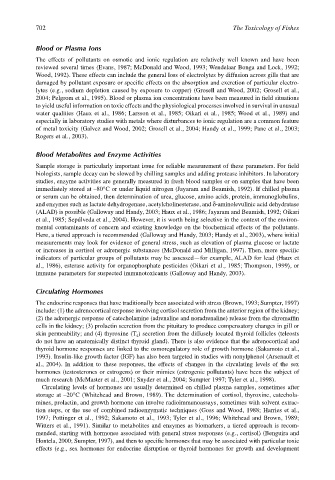Page 722 - The Toxicology of Fishes
P. 722
702 The Toxicology of Fishes
Blood or Plasma Ions
The effects of pollutants on osmotic and ionic regulation are relatively well known and have been
reviewed several times (Evans, 1987; McDonald and Wood, 1993; Wendelaar Bonga and Lock, 1992;
Wood, 1992). These effects can include the general loss of electrolytes by diffusion across gills that are
damaged by pollutant exposure or specific effects on the absorption and excretion of particular electro-
lytes (e.g., sodium depletion caused by exposure to copper) (Grosell and Wood, 2002; Grosell et al.,
2004; Pelgrom et al., 1995). Blood or plasma ion concentrations have been measured in field situations
to yield useful information on toxic effects and the physiological processes involved in survival in unusual
water qualities (Haux et al., 1986; Larsson et al., 1985; Oikari et al., 1985; Wood et al., 1989) and
especially in laboratory studies with metals where disturbances to ionic regulation are a common feature
of metal toxicity (Galvez and Wood, 2002; Grosell et al., 2004; Handy et al., 1999; Pane et al., 2003;
Rogers et al., 2003).
Blood Metabolites and Enzyme Activities
Sample storage is particularly important issue for reliable measurement of these parameters. For field
biologists, sample decay can be slowed by chilling samples and adding protease inhibitors. In laboratory
studies, enzyme activities are generally measured in fresh blood samples or on samples that have been
immediately stored at –80°C or under liquid nitrogen (Jayaram and Beamish, 1992). If chilled plasma
or serum can be obtained, then determination of urea, glucose, amino acids, protein, immunoglobulins,
and enzymes such as lactate dehydrogenase, acetylcholinesterase, and δ-aminolevulinic acid dehydratase
(ALAD) is possible (Galloway and Handy, 2003; Haux et al., 1986; Jayaram and Beamish, 1992; Oikari
et al., 1985; Sepúlveda et al., 2004). However, it is worth being selective in the context of the environ-
mental contaminants of concern and existing knowledge on the biochemical effects of the pollutants.
Here, a tiered approach is recommended (Galloway and Handy, 2003; Handy et al., 2003), where initial
measurements may look for evidence of general stress, such as elevation of plasma glucose or lactate
or increases in cortisol or adrenergic substances (McDonald and Milligan, 1997). Then, more specific
indicators of particular groups of pollutants may be assessed—for example, ALAD for lead (Haux et
al., 1986), esterase activity for organophosphate pesticides (Oikari et al., 1985; Thompson, 1999), or
immune parameters for suspected immunotoxicants (Galloway and Handy, 2003).
Circulating Hormones
The endocrine responses that have traditionally been associated with stress (Brown, 1993; Sumpter, 1997)
include: (1) the adrenocortical response involving cortisol secretion from the anterior region of the kidney;
(2) the adrenergic response of catecholamine (adrenaline and noradrenaline) release from the chromaffin
cells in the kidney; (3) prolactin secretion from the pituitary to produce compensatory changes in gill or
skin permeability; and (4) thyroxine (T ) secretion from the diffusely located thyroid follicles (teleosts
4
do not have an anatomically distinct thyroid gland). There is also evidence that the adrenocortical and
thyroid hormone responses are linked to the osmoregulatory role of growth hormone (Sakamoto et al.,
1993). Insulin-like growth factor (IGF) has also been targeted in studies with nonylphenol (Arsenault et
al., 2004). In addition to these responses, the effects of changes in the circulating levels of the sex
hormones (testosterones or estrogens) or their mimics (estrogenic pollutants) have been the subject of
much research (McMaster et al., 2001; Snyder et al., 2004; Sumpter 1997; Tyler et al., 1998).
Circulating levels of hormones are usually determined on chilled plasma samples, sometimes after
storage at –20°C (Whitehead and Brown, 1989). The determination of cortisol, thyroxine, catechola-
mines, prolactin, and growth hormone can involve radioimmunoassays, sometimes with solvent extrac-
tion steps, or the use of combined radioenzymatic techniques (Goss and Wood, 1988; Harries et al.,
1997; Pottinger et al., 1992; Sakamoto et al., 1993; Tyler et al., 1996; Whitehead and Brown, 1989;
Witters et al., 1991). Similar to metabolites and enzymes as biomarkers, a tiered approach is recom-
mended, starting with hormones associated with general stress responses (e.g., cortisol) (Benguira and
Hontela, 2000; Sumpter, 1997), and then to specific hormones that may be associated with particular toxic
effects (e.g., sex hormones for endocrine disruption or thyroid hormones for growth and development

